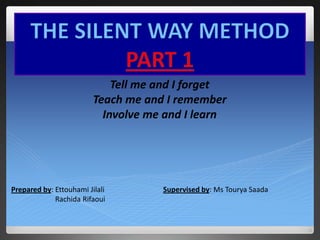
The silent way
- 1. Prepared by: Ettouhami Jilali Supervised by: Ms Tourya Saada Rachida Rifaoui Tell me and I forget Teach me and I remember Involve me and I learn
- 2. THE CONTENTS - Background - Principles - Goals - Role of the teacher - Role of the student - Characteristics of the teaching/learning process - Nature of student/teacher interaction - How are students’ feelings dealt with
- 3. THE BACKGROUND The silent way(SW), a method of language teaching, originated in the early 1970s and introduced by Caleb Gattegno, who, a European educator, is well known for the use of colored sticks called cuisenaire rods and for his approach to the teaching of initial reading in which sounds are taught by colors.
- 4. THE PRINCIPLES The central principle of the silent way is that teaching should be subordinated to learning. The other main principles are: Learning is facilitated if the learner discovers or creates rather than remembers and repeats what is to be learned Learning is facilitated by accompanying (mediating) physical objects Learning is facilitated by problem solving involving the material to be learned. (Richard and Rogers, 2001:81)
- 5. Students should learn to rely on each other and themselves. Learning involves transferring what one knows to new contexts. Meaning is made clear by focussing students’ perceptions, not through translations. If the teacher praises students, they will be less self-reliant. At the beginning the teacher needs to look for progress not perfection. The teacher can gain valuable information from students’ feedback. The skills of speaking, reading, and writing reinforce one another
- 6. THE GOALS OF THE SILENT WAY Students are able to use the language for self-expression. They need to develop independence from the teacher, to develop their own criteria for correctness. They become independent by relying on themselves. The teacher should give them only what they absolutely need to promote their learning.
- 7. THE ROLE OF THE TEACHER The teacher silently monitors learner’s interaction between each others. Responsible for designing teaching sequences and creating individual lessons and lesson elements. Uses gestures, charts, and manipulates in order to elicit and shape student’s response. The teacher’s job is to teach, to test and to get out of the way. Testing flows immediately. Teacher presents an item once.
- 8. THE ROLE OF THE LEARNER Expected to develop independence, autonomy and responsibility. Expected to interact with each other and suggest alternative for each other. Required to develop “inner criteria” for self-correctness. And to actively engage in exploring the language. No one can learn for us, Gattegno would say; to learn is our own personal responsibility. A learner must be a teacher, a student, a part of support system, a problem solver and also self evaluator.
- 9. THE CHARACTERISTICS OF THE TEACHING/LEARNING PROCESS Students begin their study of the language through its basic building blocks, its sounds. Sounds are introduced through a language-specific sound-color chart. Relying on what sounds students already know from their knowledge of their native language, teachers lead their students to associate the sounds of the target language with particular colors. Later, these same colors are used to help students learn the spellings that correspond to the sounds and how to read and pronounce words properly.
- 10. The teacher sets up situations that focus student attention on the structures of the language. Situations typically involve only one structure at a time. With minimal spoken cues, the students are guided to produce the structure. The teacher uses the students' errors as evidence of where the language is unclear to students. The students receive a great deal of practice with a given target language structure without repetition for its own sake.
- 11. THE NATURE OF TEACHER/STUDENT INTERACTION - the teacher is silent, he is still very active, - setting up situations to 'force awareness,' - listening attentively to students’ speech, and - silently working with them on their production through the use of nonverbal gestures and the tools he has available. - When the teacher does speak, it is to give clues, not to model the language.
- 12. HOW ARE THE STUDENTS’ FEELINGS DEALT WITH? The teacher constantly observes the students. When their feelings interfere, the teacher tries to find ways for the students to overcome them. Also, through feedback sessions at the end of lessons, students have an opportunity to express how they feel. The teacher takes what they say into consideration and works with the students to help them overcome negative feelings which might otherwise interfere with their learning. Because students are encouraged throughout each lesson to cooperate with one another, it is hoped that a relaxed, enjoyable learning environment will be created.
